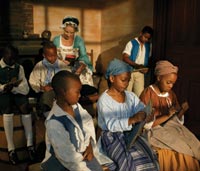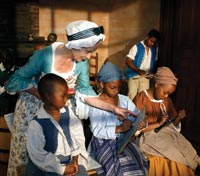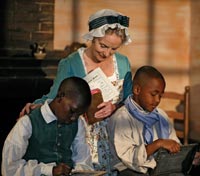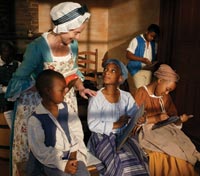
Dave Doody
Interpreter Antoinette Brennan recreates the headmistress Ann Wager, who ran a school for fourteen years for enslaved children.

Dave Doody
The raw basics of reading, writing, arithmetic were all Wager could fit into the “little schooling” she could give the children.
Peopling the Past: Meet Ann Wager
by Ed Crews
Ann Wager bridged a gap between Williamsburg’s black and white communities in the years before the American Revolution. She was the white headmistress of the Bray School, which educated enslaved children. Wager, a widow, ran the school from its opening in 1760 until her death in 1774, when it closed. Antoinette Brennan, speaking as Wager might, discusses the school, her pupils, the joys—and challenges—of being a teacher in the early 1770s.
- Hello, Mrs. Wager. School done for today?
Yes, it is, and I am tired. It is a lot of work keeping up with thirty-four children. We start early and try to do as much as we can while we have enough daylight. Yet I love teaching. I always feel like I am doing God’s work. For me, being a teacher is like throwing a pebble in a lake and watching the ripples. You never know who you will affect or how you may change them.
- How did you learn to be a teacher?
Well, I learned by doing. I tutored other children before the school opened. Since my husband died, this skill has allowed me a degree of financial independence. Of course, I learned to read when I was a child. My father was a minister and believed I should gain this skill. My mother objected. She was fearful that I might read a novel. Nevertheless, she rarely crossed my father. So I learned to read, and mother adjusted to it. I eventually would read to her, sitting by the fire at home.
- Why do they call this the Bray School?
It is named for the Reverend Dr. Thomas Bray, an Englishman. He wanted Negro children to learn how to read so they could study the Bible and catechism of the Church of England. He believed literacy would save their souls. Dr. Bray was persuasive. When an admirer died and left him £900, he used the money to create schools and to supply them. The first one opened in Philadelphia during 1758. Williamsburg’s opened in 1760 thanks to strong encouragement by Benjamin Franklin.
- How old are your students?
Some are as young as three; others as old as eight. I rarely have them for very long. A few years at most. Even if they come for several years, some do not attend school regularly. They only can come when their masters allow them. With white children, if the parents decide to send them to school, they will go for much longer. I must say that none of the students at the Bray School are getting an education. At best, they are getting a little schooling. We must cover a lot of ground in a short period—reading, writing, punctuation, spelling, and some simple arithmetic. The girls also learn to sew and to embroider. I always tell them: “Remember: twelve stitches to the inch.”
- Do you feed the children as well as teach them?
Goodness, no! I cannot prepare dinner six days a week for four and thirty children. They can bring their own food or go home to eat.
- Is the school well supplied?
We have an excellent selection of books, although some are too advanced for children so young. None of them are going to read a collection of sermons. I even received a book that is supposed to make me a better teacher—The Easy Method of Instructing Youth. Every time I see the title, it amuses me. Of course, the children learn to write using slates. Paper is too expensive, and we certainly would need a lot of it. The College of William and Mary sends me firewood when it gets cold.
- Do you ever have discipline problems?
Never. I tell the children that they must behave in class and do my bidding. If they do not, then I will send them home, where they will do their master’s bidding. All of them prefer my tasks to the master’s.
- You have taught black and white children. Do you notice differences in their abilities?
I see none. On this topic, I agree completely with Mr. Franklin. He has been a strong advocate for the Bray Schools. He wrote that he had “observed the Negro child, and found their apprehension to be as quick, their memory to be as strong, and their docility to be every bit equal to that of the white child.”
Editor’s note: Another installment in a series of first person, question-and-answer articles condensed and distilled from interviews with interpreters portraying historic figures at Colonial Williamsburg.


